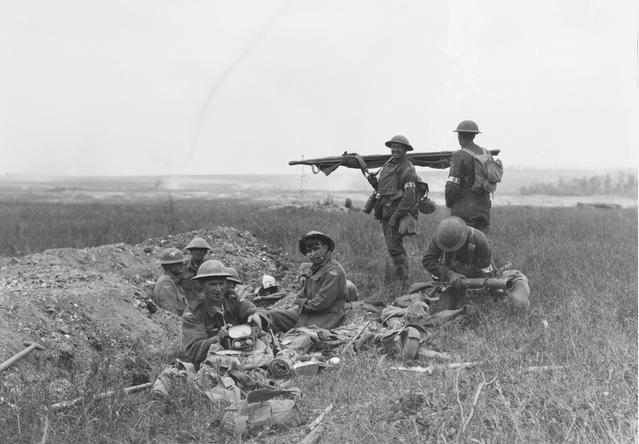
At 3.10 on the morning of 4 July 1918, three brigades of Australian infantry carried out a successful attack on the German positions outside the village of Le Hamel on the southern banks of the Somme River in northern France. U
Under the direction of Lieutenant General Sir John Monash, the newly appointed commander of the Australian Corps, all assaulting units involved took their objectives in just 93 minutes.
With infantry, armour, artillery and air assets at his disposal, Monash had the good fortune of commanding a recognisably modern integrated weapons system that characterised much of the fighting during the final allied campaigns on the Western Front. In his postwar account, Monash likened this all-arms battle to a symphony for which he had been conductor:
A perfected modern battle plan is like nothing so much as a score for an orchestral composition, where the various arms and units are the instruments, and the tasks they perform are their respective musical phrases. Every individual unit must make its entry precisely at the proper moment, and play its phrase in the general harmony.
Monash had commanded the Australian Corps for little more than a month before the battle of Hamel, which was the first major offensive action by the British Expeditionary Force (BEF) since Cambrai in November 1917. The newly formed Australian Corps had been spared the weight of German attacks that devastated British formations on the Somme and at Arras in April and May and were holding a section of the front line that sat astride the Somme River near the town of Villers-Bretonneux.
Australian raids and patrols gave every indication that German morale was low and their defences poor. The German failure to achieve a decisive victory against the British and French before vast numbers of newly arrived Americans were combat-ready put the allies in a better position than ever to deliver their own counteroffensive. The German defences opposite the Australian Corps at Le Hamel proved a good place to start.
Knowing the British tank corps was eager to test the new Mark V tank in combat, the officer commanding the British Fourth Army, General Sir Henry Rawlinson, invited Monash and the commander of the tank brigade assigned to the formation to devise an operation with the purpose of straightening a bend in the line on the Australian front.
These proposals stressed the element of surprise by silently registering guns in accordance with new artillery methods and air support, and both plans suggested an attack with limited objectives involving infantry and armour. Attacking along a six-kilometre front, the infantry at Le Hamel would be supported by every technological and tactical advantage possible. Monash included two companies of inexperienced Americans (about 1,000 men) to add weight to the 10 battle-depleted Australian battalions tasked with the assault.
As at Messines, Monash planned the Hamel battle fastidiously—every detail was rehearsed at conferences with commanders and staff of all the services involved. No fewer than 250 officers were present at the final meeting on 30 June; the agenda included 133 items and the meeting lasted four and a half hours. Monash told Rawlinson:
The underlying principle of the conference was that everyone that mattered was present, and had to explain his plans and proposals; and that, where there was any conflict, or doubt or difference of opinion, the final unalterable decision was given there and then, and no subsequent fiddling with the plan was permitted.
The popular view that Monash ‘invented’ the tactics used in the battle of Hamel overlooks the importance of the idea-sharing that occurred among experts involved in the planning. Like all commanders within the BEF at that time, Monash deliberately tapped the rich vein of tactical learning and development that had been built up throughout the previous four years of fighting. Monash benefited from the latest attack doctrine, ideas and technologies based on the successes and failures of previous engagements.
None of the tactical elements used at Le Hamel were being done for the first time. It has been claimed that this battle was the first time ammunition had been dropped to front-line troops (in fact, this was done by the German air service in May 1918), the first time aircraft had been used to mask the sound of tanks forming up (carried out by the Royal Flying Corps at Poelcapelle in August 1917), and the first time smoke and gas had been mixed in habituating barrages to try to trick the Germans into wearing their gas masks during the attack (used by the British as early the battle of the Somme in 1916).
Counter-bombardments, creeping barrages and predicted fire were perfected throughout the myriad battles of 1916–17, while machine-gun barrages were said to be the touchstone of British expertise by mid-1917. The Australian experience of the Third Battle of Ypres demonstrated the effective use of firepower to support attacks with limited objectives, most notably the ‘bite and hold’ battles at Menin Road, Polygon Wood and Broodseinde throughout September and October 1917.
Employing these methods, the battle of Hamel was a resounding success. The Germans were caught by surprise and all assaulting units were on their objectives within 93 minutes. The Australian Corps and the British and American units involved suffered 1,400 casualties, while German losses were estimated to be around 2,000 (which included 1,600 prisoners).
Although small in scale, Hamel was a practical demonstration of an attack with limited objectives using combined arms tactics. It was these kinds of attacks that succeeded in winning battles in 1918, success Monash attributed to ‘the perfection of teamwork’.

